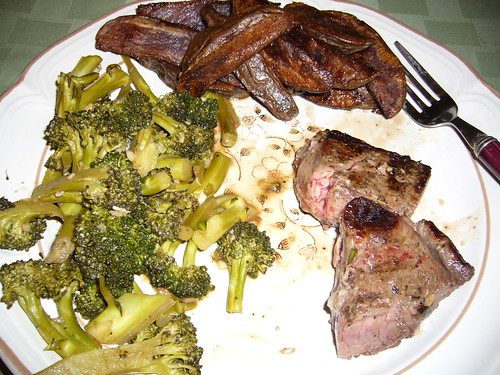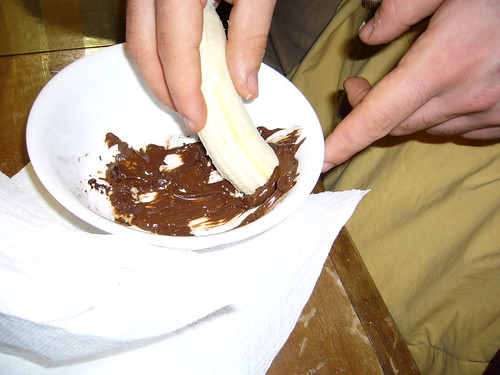 Lamb again?
Lamb again? you're thinking. I know, I've gotten myself into some kind of rut, between all the lamb, and and potatoes, and roasted beets, and the staples of cooking through a winter that just won't end. It will be April in two days, and yet it's still been too cold to go for a bike ride (in my opinion).
Since it's still acting like winter, I figured I might as well cook like it by warming up the apartment with some braising action after work last Wednesday. This time around, I was dealing with lamb shoulder chops, which are a cheaper and tougher cut than the
lamb rib chops that I grilled up the other week, so I figured they would benefit from a tenderizing braise in the oven. I diced onions and garlic and sauteed them in a large pan with olive oil over medium heat. Since the pan was large enough and the lamb chop small enough (only about .65 lb - part of my ploy to save money and eat less meat), I also browned the lamb at the same time. I added about 2/3 cup red wine, salt, pepper, tarragon, and thyme to the pan, and let it come to a simmer to reduce the wine a little. Then I transfered it all to a casserole dish and put it in the oven at 375 for an hour and a half.
I had enough time to take a shower, put on my comfy pajamas, and begin a glass of wine before I needed to start preparing the smashed potatoes and celery root. My inspiration was Alice Waters' recipe for celery root and potato puree in her holy-grail-of-seasonal-cooking-book,
The Art of Simple Food. I was lucky enough to find this book on the shelf at the library last week and it's now on the (extremely) short list of books I deem worthy of owning. You see, I don't really like owning books or movies. It seems like a waste of money, space, and environmental resources. I much prefer taking things out from the library when I want to enjoy them. But,
The Art of Simple Food is an encyclopediac resource of the building blocks of cooking that I would love to have on hand year round. I surely won't be able to absorb much before I have to return it in a couple weeks.
This was my first foray into cooking celery root, or celeriac, which is a kind of celery prized for its large root rather than its stems. It really did have a faint whiff and taste of regular celery. Alice Waters wanted me to peel it, slice it thinly, throw it in a pan with 3 tbsp butter, and let it cook covered for 15 minutes until tender. However, I get scared cooking with a lot of butter, so I cooked it with 1 tbsp butter and about a 1/3 cup water. It browned a little, but I like to think that added to the flavor. Meanwhile, I cooked blue and red potatoes (hence the pinkish color in the photo) in salted boiling water for about 15 minutes until tender. Then Alice Waters wanted me to push all the veggies through a ricer to puree them. But since I don't have a ricer and I wasn't in the mood to have to wash my food processor either, I just mashed them all with a fork, leaving some chunks, added a little milk and butter, and called it smashed potatoes and celery root instead.
I served the lamb and onion over large dollops of the smashed stuff, and then spooned the braising liquid on top. On the side, we ate a salad of local bitter greens (baby kale and mustard) with a balsamic vinaigrette and toasted (more like burned) almonds. It doesn't look very pretty, and the dish wasn't anything to coo over. It was just an average meal. The sweetness of the braised red wine covered up the elegant celery flavor so much that Jesse said he didn't taste celery at all. And the flavors of the dish altogether were pretty muted. I actually noticed that the red wine, Barbera d'Alba, was too spicy and overpowering in comparison, and my wine palate is usually never that discerning.
Later that night, I had to change back out of my comfy pajamas into hipster clothing for an absinthe open bar down the block. I do not recommend this is a way to try absinthe. The bartender was pushing half-full shots of watered-down pale green absinthe at us. It tasted like a watery licorice liquor that went down easy, but wasn't very exciting.
On another side note, I do recommend watching
this Laurie Anderson video. I don't know much of anything about Laurie Anderson or her music, except that my uncle played in her band in the 80s, but I accompanied Jesse to see her perform selections from her new album
Homeland at Carnegie Hall last week. I thought half the songs had a very boring feel, with ambient accompaniment and her weak voice singing the same refrains over and over again. The other half were much better - more like spoken word with music - very witty and engaging and relevant to the state of America today, and also very liberal, especially for Carnegie Hall. The highlight was "Only an Expert," which offers a critique of how the American populace sucumbs to the whims of "experts," whether those be big companies, media, or politicians. Check it out on YouTube
here.















































 As an appetizer, we enjoyed slices of fresh baked bread with olive oil and balsamic vinegar. This was my second attempt at baking a whole wheat loaf based on the Loaf for Learning in the Laurel's Kitchen Guide to Whole Grain Bread Baking, and it came out moister and more flavorful than
As an appetizer, we enjoyed slices of fresh baked bread with olive oil and balsamic vinegar. This was my second attempt at baking a whole wheat loaf based on the Loaf for Learning in the Laurel's Kitchen Guide to Whole Grain Bread Baking, and it came out moister and more flavorful than 

 To top things off, Jesse picked up a bottle of red wine at
To top things off, Jesse picked up a bottle of red wine at